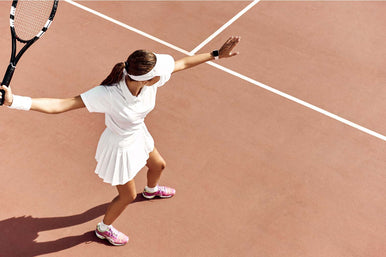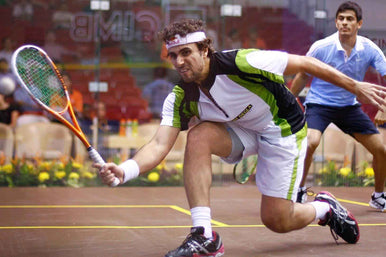

There are few sports where your choice of equipment can make such a huge difference to your ability to play. A good tennis player can play well with any racket, but to truly play to your potential, you need a racket that suits you perfectly and allows you to play to your strengths.
Finding the perfect racket can help you play better, hit harder, hit those corners of the court, and may give you that slight advantage you need during a gruelling rally.
In this article, we will look at the differences between beginner, intermediate, and advanced rackets and help you decide which suits you best. We will also look at grip size, head size, length, and all the other factors that should come in to your considerations.
We will also look at how to properly maintain your racket once you’ve bought it, and some frequently asked questions.
Types of Tennis Rackets
There are several ways to categorise tennis rackets, but the most simplistic way to do so is to sort them into beginner rackets, intermediate rackets, and advanced rackets. Of course, there will be many rackets that fit comfortably between categories.
Beginner Tennis Rackets
A beginner tennis racket is a racket that is designed for either brand new tennis players, or for casual players who may only play a couple of friendly matches a year. These rackets are often relatively inexpensive and are made from aluminium.
This makes them very lightweight, which is ideal for someone who rarely plays. Not only are they often light, but they also have a larger racket head. This means that the sweet spot (ideal spot to hit the ball with) is larger, meaning the player is less likely to mishit the ball.
Beginner tennis rackets tend to offer less power, but this isn’t usually an issue. Most people have the ability to hit the ball hard, but hitting the ball accurately is a big issue for beginners. Adding power while technique is in its infancy can lead to players hitting the ball out of play more often.
The vast majority of people who play tennis recreationally will fit easily into the beginner category unless you play every week.
Intermediate Tennis Rackets
To be honest, the intermediate category is a difficult one to define. It is aimed at people who are confident in their game, and play regularly, but aren’t yet near their potential. If you have been playing once a week for 2 years, then you probably fit into the intermediate category.
Tennis rackets that fit this category would be best described as slightly more expensive versions of beginner rackets, or slightly less expensive versions of advanced rackets.
They may still be made from aluminium, or they will be made from a graphite blend (usually thermoplastic or fiberglass resin).
The intermediate tennis racket will weigh a little bit more than a beginner racket, will usually have a midsize head, and will be slightly more powerful.
Advanced Tennis Rackets
If you have truly mastered your game, then progressing to an advanced tennis racket is the final piece of the puzzle.
An advanced tennis racket is less forgiving, with a smaller head size and smaller sweet spot. Thanks to a graphite frame it will be much more powerful, relying on your technique and accuracy to keep the ball in play.
Advanced tennis rackets will of course be the most expensive out of the three categories, as they are made from the costliest materials. But you are paying for a racket that will bring out the best from your game.
How to Choose a Grip Size
Most people don’t really think about grip size when they purchase a racket, but it is actually very important. A bad grip size can contribute to tennis elbow, by requiring you to grip too hard (this will happen whether the grip is too wide or too small).
Luckily, it’s fairly easy to determine whether the grip size of a racket is correct or not. Hold your hand out with fingers extended, using a ruler or tape measure, place the end just above the highest line on your palm. This is known as the bottom lateral crease.
Measure to the tip of your ring finger. There are six grip measurements, they are either accompanied with an L or a G. In the US, grip sizes are just the measurement in inches.
Small Grips:
- (L0 or G0) If the distance from your bottom lateral crease to ring finger tip is 4 inches, then your grip size is L0 or G0.
- (L1 or G1) If the distance from your bottom lateral crease to ring finger tip is 4 and 1/8 inches, then your grip size is L1 or G1.
- (L2 or G2) If the distance from your bottom lateral crease to ring finger tip is 4 and ¼ inches, then your grip size is L2 or G2.
Medium Grips:
- (L3 or G3) If the distance from your bottom lateral crease to ring finger tip is 4 and 3/8 inches, then your grip size is L3 or G3.
- (L4 or G4) If the distance from your bottom lateral crease to ring finger tip is 4 and ½ inches, then your grip size is L4 or G4.
Large Grips:
- (L5 or G5) If the distance from your bottom lateral crease to ring finger tip is 4 and 5/8 inches, then your grip size is L5 or G5.
If you are between sizes, then go for the smaller one. If your grip size is larger than L5 or G5 then you can use a heat shrink sleeve to increase the size slightly. This is what the professionals do.
Things to Consider
Here is a list of things to consider when purchasing a racket, many of these have been covered in the “types of racket” section, so read that first to give you a good idea of what you want.
Head Size
The larger the head, the bigger the sweet spot, meaning that you can hit the ball more accurately. Larger head sizes are great for beginners, while smaller head sizes are better for experienced players who want more power.
Length
A standard adult’s racket is 27 inches in length. Smaller rackets are a minimum of 26.5 inches, and the longest racket allowed in a tournament is 29
inches. A longer racket will generate more power but requires more strength and power to operate. Most tennis players suit the standard 27 inches.
Weight Distribution
There are three types of weight distribution when it comes to tennis rackets. Head heavy, head light, or even balanced. Head light rackets are heavier overall but allow for greater manoeuvrability. Head heavy rackets tend to be more lightweight and provide greater power.
Grip Size
As discussed above, finding the right grip size for your hand will help you to hit better, feel more comfortable during long rallies, and help to prevent tennis elbow. Measure your grip and find a racket size to suit.
Material
Beginners rackets are the cheapest to buy and are mostly made of aluminium. More advanced rackets are made from graphite blended with either thermoplas tic or fiberglass, while the most expensive rackets may be pure graphite.
Swing
This is a measure of how much the racket weighs while you swing it. Appropriately it is measured in swingweight. Beginners will suit a low swingweight (305 or below), intermediate players will suit medium swingweight (310 to 325) and advanced players will suit high swingweights of 325 or above. A high swingweight increases the stability of the racket.
Extra Features
When looking at a tennis racket, any extra features that are provided with the racket could help with your decision making. But don’t let a few extra features cloud your judgement. If there are two rackets, one which suits you perfectly, and one that doesn’t quite suit you but comes with a load of extra features, pick the former!
Warranty
No tennis racket will last forever but provided you don’t “do a McEnroe” and smash your racket on the ground, it should last you a long time. Always check the warranty if you are spending a good amount on a racket. Most companies offer protection for manufacturing faults such as handle or shaft faults, or frame cracks. They should also cover string pull-throughs. No company will offer protection for general wear and tear though, or against you smashing your racket on the ground!
Your Budget
This is possibly the most important consideration when purchasing a tennis racket. How important is the racket to you? Are you going to use it religiously? Or is it something you will use for a couple weeks each summer? Adjust your budget to match your desires.
Tennis Racket Maintenance
There are three things to focus on when it comes to tennis racket maintenance, followall three and you should get the best out of your racket for a long time.
Restring
You shoul restring your racket at least twice per year. More if possible. This will really help your racket to last longer, and it will perform better as strings will provide more bounce.
Grip
Make sure that you replace your grip regularly, too many players continue using a grip that has fallen apart, but this can affect how well you hold the racket and how well you play.
Storage
As crazy as it sounds, your racket can be severely affected by very hot or very cold temperatures. Make sure you keep it away from radiators or sun spots. Don’t leave them outside either, as cold temperatures can damage the strings.


